Tungsten Based Spectrally Selective Absorbers with Anisotropic Rough Surface Texture
Abstract
1. Introduction
2. Materials and Methods
3. Results and Discussion
4. Conclusions
Author Contributions
Funding
Institutional Review Board Statement
Informed Consent Statement
Data Availability Statement
Conflicts of Interest
References
- Han, X.; He, K.; He, Z.; Zhang, Z. Tungsten-based highly selective solar absorber using simple nanodisk array. Opt. Express 2017, 25, A1072–A1078. [Google Scholar] [CrossRef]
- Sibin, K.P.; John, S.; Barshilia, H.C. Control of thermal emittance of stainless steel using sputtered tungsten thin films for solar thermal power applications. Sol. Energy Mater. Sol. Cells 2015, 133, 1–7. [Google Scholar] [CrossRef]
- Cao, F.; Kraemer, D.; Sun, T.; Lan, Y.; Chen, G.; Ren, Z. Enhanced Thermal Stability of W-Ni-Al2O3 Cermet-Based Spectrally Selective Solar Absorbers with Tungsten Infrared Reflectors. Adv. Energy Mater. 2015, 5, 1401042. [Google Scholar] [CrossRef]
- Silva-Oelker, G.; Jerez-Hanckes, C.; Fay, P. High-temperature tungsten-hafnia optimized selective thermal emitters for thermophotovoltaic applications. J. Quant. Spectrosc. Radiat. Transf. 2019, 231, 61–68. [Google Scholar] [CrossRef]
- Khan, A.; Elliman, R.; Corr, C.; Lim, J.J.H.; Forrest, A.; Mummery, P.; Evans, L.M. Effect of rhenium irradiations on the mechanical properties of tungsten for nuclear fusion applications. J. Nucl. Mater. 2016, 477, 42–49. [Google Scholar] [CrossRef]
- Rieth, M.; Dudarev, S.L.; De Vicente, S.M.G.; Aktaa, J.; Ahlgren, T.; Antusch, S.; Armstrong, D.E.J.; Balden, M.; Baluc, N.; Barthe, M.-F. Recent progress in research on tungsten materials for nuclear fusion applications in Europe. J. Nucl. Mater. 2013, 432, 482–500. [Google Scholar] [CrossRef]
- Marinelli, G.; Martina, F.; Lewtas, H.; Hancock, D.; Mehraban, S.; Lavery, N.; Ganguly, S.; Williams, S. Microstructure and thermal properties of unalloyed tungsten deposited by Wire+ Arc Additive Manufacture. J. Nucl. Mater. 2019, 522, 45–53. [Google Scholar] [CrossRef]
- Liu, R.; Wang, Z.; Sparks, T.; Liou, F.; Newkirk, J. Aerospace applications of laser additive manufacturing. In Laser Additive Manufacturing; Elsevier: Amsterdam, The Netherlands, 2017; pp. 351–371. [Google Scholar]
- Ungaro, C.; Gray, S.K.; Gupta, M.C. Black tungsten for solar power generation. Appl. Phys. Lett. 2013, 103, 71105. [Google Scholar] [CrossRef]
- Wang, H.; Wang, L. Perfect selective metamaterial solar absorbers. Opt. Express 2013, 21, A1078–A1093. [Google Scholar] [CrossRef]
- Song, J.; Si, M.; Cheng, Q.; Luo, Z. Two-dimensional trilayer grating with a metal/insulator/metal structure as a thermophotovoltaic emitter. Appl. Opt. 2016, 55, 1284–1290. [Google Scholar] [CrossRef]
- Zhang, H.; Luo, M.; Zhou, Y.; Ji, Y.; Chen, L. Ultra-broadband, polarization-independent, wide-angle near-perfect absorber incorporating a one-dimensional meta-surface with refractory materials from UV to the near-infrared region. Opt. Mater. Express 2020, 10, 484–491. [Google Scholar] [CrossRef]
- Rakić, A.D.; Djurišić, A.B.; Elazar, J.M.; Majewski, M.L. Optical properties of metallic films for vertical-cavity optoelectronic devices. Appl. Opt. 1998, 37, 5271–5283. [Google Scholar] [CrossRef]
- Rephaeli, E.; Fan, S. Tungsten black absorber for solar light with wide angular operation range. Appl. Phys. Lett. 2008, 92, 211107. [Google Scholar] [CrossRef]
- Rinnerbauer, V.; Lenert, A.; Bierman, D.M.; Yeng, Y.X.; Chan, W.R.; Geil, R.D.; Senkevich, J.J.; Joannopoulos, J.D.; Wang, E.N.; Soljačić, M. Metallic photonic crystal absorber-emitter for efficient spectral control in high-temperature solar thermophotovoltaics. Adv. Energy Mater. 2014, 4, 1400334. [Google Scholar] [CrossRef]
- Celanovic, I.; Jovanovic, N.; Kassakian, J. Two-dimensional tungsten photonic crystals as selective thermal emitters. Appl. Phys. Lett. 2008, 92, 193101. [Google Scholar] [CrossRef]
- Wang, H.; Sivan, V.P.; Mitchell, A.; Rosengarten, G.; Phelan, P.; Wang, L. Highly efficient selective metamaterial absorber for high-temperature solar thermal energy harvesting. Sol. Energy Mater. Sol. Cells 2015, 137, 235–242. [Google Scholar] [CrossRef]
- Khodasevych, I.E.; Wang, L.; Mitchell, A.; Rosengarten, G. Micro and nanostructured surfaces for selective solar absorption. Adv. Opt. Mater. 2015, 3, 852–881. [Google Scholar] [CrossRef]
- Gupta, M.C.; Ungaro, C.; Foley IV, J.J.; Gray, S.K. Optical nanostructures design, fabrication, and applications for solar/thermal energy conversion. Sol. Energy 2018, 165, 100–114. [Google Scholar] [CrossRef]
- Shah, A.A.; Gupta, M.C. Spectral selective surfaces for concentrated solar power receivers by laser sintering of tungsten micro and nano particles. Sol. Energy Mater. Sol. Cells 2013, 117, 489–493. [Google Scholar] [CrossRef]
- Kecebas, M.A.; Menguc, M.P.; Kosar, A.; Sendur, K. Spectrally selective filter design for passive radiative cooling. JOSA B 2020, 37, 1173–1182. [Google Scholar] [CrossRef]
- Gupta, M.C.; Carlson, D.E. Laser processing of materials for renewable energy applications. MRS Energy Sustain. 2015, 2, 285–310. [Google Scholar] [CrossRef]
- Jeong, H.-J.; Kim, Y.-C.; Lee, S.K.; Yun, J.-H.; Jang, J.-H. Enhanced spectral response of CIGS solar cells with anti-reflective subwavelength structures and quantum dots. Sol. Energy Mater. Sol. Cells 2019, 194, 177–183. [Google Scholar] [CrossRef]
- Benamira, A.; Pattanaik, S. Application of the Transfer Matrix Method to Anti-reflective Coating Rendering. In Proceedings of the Computer Graphics International Conference; Springer: Cham, Switzerland, 2020; pp. 83–95. [Google Scholar]
- Hobbs, D.S. Random Texture Anti-Reflection Optical Surface Treatment. U.S. Patent 8,187,481, 29 May 2012. [Google Scholar]
- Cho, C.; Kim, H.; Jeong, S.; Baek, S.-W.; Seo, J.-W.; Han, D.; Kim, K.; Park, Y.; Yoo, S.; Lee, J.-Y. Random and V-groove texturing for efficient light trapping in organic photovoltaic cells. Sol. Energy Mater. Sol. Cells 2013, 115, 36–41. [Google Scholar] [CrossRef]
- Goulas, A.; Zhang, S.; McGhee, J.R.; Cadman, D.A.; Whittow, W.G.; Vardaxoglou, J.C.; Engstrøm, D.S. Fused filament fabrication of functionally graded polymer composites with variable relative permittivity for microwave devices. Mater. Des. 2020, 193, 108871. [Google Scholar] [CrossRef]
- Carbonaro, C.M.; Corpino, R.; Salis, M.; Mocci, F.; Thakkar, S.V.; Olla, C.; Ricci, P.C. On the emission properties of carbon dots: Reviewing data and discussing models. C 2019, 5, 60. [Google Scholar] [CrossRef]
- Chen, C.; Wang, J.; Gao, Y. Wavelength-Dependent Nonlinear Absorption in Palladium Nanoparticles. Appl. Sci. 2021, 11, 1640. [Google Scholar] [CrossRef]
- Baffou, G.; Cichos, F.; Quidant, R. Applications and challenges of thermoplasmonics. Nat. Mater. 2020, 19, 946–958. [Google Scholar] [CrossRef]
- Zograf, G.P.; Petrov, M.I.; Makarov, S.V.; Kivshar, Y.S. All-dielectric thermonanophotonics. arXiv 2021, arXiv:2104.01964. [Google Scholar]
- Zograf, G.P.; Petrov, M.I.; Zuev, D.A.; Dmitriev, P.A.; Milichko, V.A.; Makarov, S.V.; Belov, P.A. Resonant nonplasmonic nanoparticles for efficient temperature-feedback optical heating. Nano Lett. 2017, 17, 2945–2952. [Google Scholar] [CrossRef]
- Gandolfi, M.; Crut, A.; Medeghini, F.; Stoll, T.; Maioli, P.; Vallée, F.; Banfi, F.; Del Fatti, N. Ultrafast thermo-optical dynamics of plasmonic nanoparticles. J. Phys. Chem. C 2018, 122, 8655–8666. [Google Scholar] [CrossRef]
- Ishii, S.; Sugavaneshwar, R.P.; Nagao, T. Titanium nitride nanoparticles as plasmonic solar heat transducers. J. Phys. Chem. C 2016, 120, 2343–2348. [Google Scholar] [CrossRef]
- Li, M.; Lohmuller, T.; Feldmann, J. Optical injection of gold nanoparticles into living cells. Nano Lett. 2015, 15, 770–775. [Google Scholar] [CrossRef]
- Kristensen, A.; Yang, J.K.W.; Bozhevolnyi, S.I.; Link, S.; Nordlander, P.; Halas, N.J.; Mortensen, N.A. Plasmonic colour generation. Nat. Rev. Mater. 2016, 2, 1–14. [Google Scholar] [CrossRef]
- Gandolfi, M.; Banfi, F.; Glorieux, C. Optical wavelength dependence of photoacoustic signal of gold nanofluid. Photoacoustics 2020, 20, 100199. [Google Scholar] [CrossRef] [PubMed]
- Celebrano, M.; Rocco, D.; Gandolfi, M.; Zilli, A.; Rusconi, F.; Tognazzi, A.; Mazzanti, A.; Ghirardini, L.; Pogna, E.A.A.; Carletti, L. Optical tuning of dielectric nanoantennas for thermo-optically reconfigurable nonlinear metasurfaces. Opt. Lett. 2021, 46, 2453–2456. [Google Scholar] [CrossRef]
- Tian, Y.; Ghanekar, A.; Ricci, M.; Hyde, M.; Gregory, O.; Zheng, Y. A review of tunable wavelength selectivity of metamaterials in near-field and far-field radiative thermal transport. Materials 2018, 11, 862. [Google Scholar] [CrossRef] [PubMed]
- Wu, Z.; Xue, W.; Liu, Y.; Wei, D.; Wang, J.; Yin, L.; Wang, Y.; Liu, X.; Zhang, Q.; Cao, F. Toward versatile applications via tuning transition wavelength of the WTa-SiO2 based spectrally selective absorber. Sol. Energy 2020, 202, 115–122. [Google Scholar] [CrossRef]
- Calisgan, S.D.; Villanueva-Lopez, V.; Rajaram, V.; Qian, Z.; Kang, S.; Hernandez-Rivera, S.P.; Rinaldi, M. Spectroscopic chemical sensing based on narrowband MEMS resonant infrared detectors. In Proceedings of the 2018 IEEE SENSORS, New Delhi, India, 28–31 October 2018; pp. 1–4. [Google Scholar] [CrossRef]
- Zhao, B.; Hu, M.; Ao, X.; Xuan, Q.; Pei, G. Spectrally selective approaches for passive cooling of solar cells: A review. Appl. Energy 2020, 262, 114548. [Google Scholar] [CrossRef]
- Khosroshahi, F.K.; Ertürk, H.; Mengüç, M.P. Optimization of spectrally selective Si/SiO2 based filters for thermophotovoltaic devices. J. Quant. Spectrosc. Radiat. Transf. 2017, 197, 123–131. [Google Scholar] [CrossRef]
- Dan, A.; Jyothi, J.; Chattopadhyay, K.; Barshilia, H.C.; Basu, B. Spectrally selective absorber coating of WAlN/WAlON/Al2O3 for solar thermal applications. Sol. Energy Mater. Sol. Cells 2016, 157, 716–726. [Google Scholar] [CrossRef]
- Mehrabi, S.; Rezaei, M.H.; Zarifkar, A. Ultra-broadband solar absorber based on multi-layer TiN/TiO 2 structure with near-unity absorption. JOSA B 2019, 36, 2602–2609. [Google Scholar] [CrossRef]
- Chattopadhyay, S.; Huang, Y.F.; Jen, Y.J.A. Ganguly, KH Chen and LC Chen. Mater. Sci. Eng. R 2010, 69, 1–35. [Google Scholar] [CrossRef]
- Tan, H.; Santbergen, R.; Smets, A.H.M.; Zeman, M. Plasmonic light trapping in thin-film silicon solar cells with improved self-assembled silver nanoparticles. Nano Lett. 2012, 12, 4070–4076. [Google Scholar] [CrossRef]
- Bergström, D.; Powell, J.; Kaplan, A.F.H. The absorption of light by rough metal surfaces—A three-dimensional ray-tracing analysis. J. Appl. Phys. 2008, 103, 103515. [Google Scholar] [CrossRef]
- De Castro, C.P.; Luković, M.; Andrade, R.F.S.; Herrmann, H.J. The influence of statistical properties of Fourier coefficients on random Gaussian surfaces. Sci. Rep. 2017, 7, 1–8. [Google Scholar] [CrossRef]
- Niu, C.; Zhu, T.; Lv, Y. Influence of Surface Morphology on Absorptivity of Light-Absorbing Materials. Int. J. Photoenergy 2019, 2019, 1476217. [Google Scholar] [CrossRef]
- Sai, H.; Kanamori, Y. Spectrally selective thermal radiators and absorbers with periodic microstructured surface for high-temperature applications. Microscale Thermophys. Eng. 2003, 7, 101–115. [Google Scholar] [CrossRef]
- Cao, L.; Sendur, K. Surface Roughness Effects on the Broadband Reflection for Refractory Metals and Polar Dielectrics. Materials 2019, 12, 3090. [Google Scholar] [CrossRef]
- Raza, A.; Alketbi, A.S.; Devarapalli, R.; Li, H.; Zhang, T. Refractory Ultrathin Nanocomposite Solar Absorber with Superior Spectral Selectivity and Thermal Stability. Adv. Opt. Mater. 2020, 8, 2000679. [Google Scholar] [CrossRef]
- Lumerical, F. Solutions 2016. Available online: http://www.lumerical.com/ (accessed on 26 July 2021).
- Palik, E.D. Handbook of Optical Constants of Solids; Academic Press: New York, NY, USA, 1998; Volume 3, ISBN 0125444230. [Google Scholar]
- Liu, B.; Xia, X.; Sun, C. Scattering properties of solid rough surface of nickel skeleton. Infrared Phys. Technol. 2018, 93, 25–33. [Google Scholar] [CrossRef]
- Liu, Z.; Liu, G.; Huang, Z.; Liu, X.; Fu, G. Ultra-broadband perfect solar absorber by an ultra-thin refractory titanium nitride meta-surface. Sol. Energy Mater. Sol. Cells 2018, 179, 346–352. [Google Scholar] [CrossRef]
- Shimizu, M.; Yugami, H. Thermal radiation control by surface gratings as an advanced cooling system for electronic devices. J. Therm. Sci. Technol. 2011, 6, 297–306. [Google Scholar] [CrossRef][Green Version]
- Sai, H.; Yugami, H.; Kanamori, Y.; Hane, K. Solar selective absorbers based on two-dimensional W surface gratings with submicron periods for high-temperature photothermal conversion. Sol. Energy Mater. Sol. Cells 2003, 79, 35–49. [Google Scholar] [CrossRef]
- Amiri, I.S.; Sorger, V.J.; Yupapin, P. Zinc Oxide nanowire gratings for light absorption control through polarization manipulation. Phys. E Low-Dimens. Syst. Nanostruct. 2019, 108, 68–73. [Google Scholar] [CrossRef]
- Wojciechowski, S.; Twardowski, P.; Chwalczuk, T. Surface roughness analysis after machining of direct laser deposited tungsten carbide. Proc. J. Phys. Conf Ser. 2014, 483, 12018. [Google Scholar] [CrossRef]
- Maleki, E.; Bagherifard, S.; Bandini, M.; Guagliano, M. Surface post-treatments for metal additive manufacturing: Progress, challenges, and opportunities. Addit. Manuf. 2020, 37, 101619. [Google Scholar]
- Hatefi, S.; Abou-El-Hossein, K. Review of single-point diamond turning process in terms of ultra-precision optical surface roughness. Int. J. Adv. Manuf. Technol. 2020, 106, 2167–2187. [Google Scholar] [CrossRef]
- Ronchi, A.; Sterzi, A.; Gandolfi, M.; Belarouci, A.; Giannetti, C.; Del Fatti, N.; Banfi, F.; Ferrini, G. Discrimination of nano-objects via cluster analysis techniques applied to time-resolved thermo-acoustic microscopy. Ultrasonics 2021, 114, 106403. [Google Scholar] [CrossRef] [PubMed]
- Voti, R.L.; Leahu, G.L.; Gaetani, S.; Sibilia, C.; Violante, V.; Castagna, E.; Bertolotti, M. Light scattering from a rough metal surface: Theory and experiment. JOSA B 2009, 26, 1585–1593. [Google Scholar] [CrossRef]
- Larciprete, M.C.; Centini, M.; Voti, R.L.; Bertolotti, M.; Sibilia, C. Polarization insensitive infrared absorbing behaviour of one-dimensional multilayer stack: A fractal approach. Opt. Express 2014, 22, A1547–A1552. [Google Scholar] [CrossRef]
- Larciprete, M.C.; Centini, M.; Voti, R.L.; Bertolotti, M.; Sibilia, C. Metallic oriented nanowires films for infrared radiation manipulation. Appl. Phys. A 2016, 122, 343. [Google Scholar] [CrossRef]

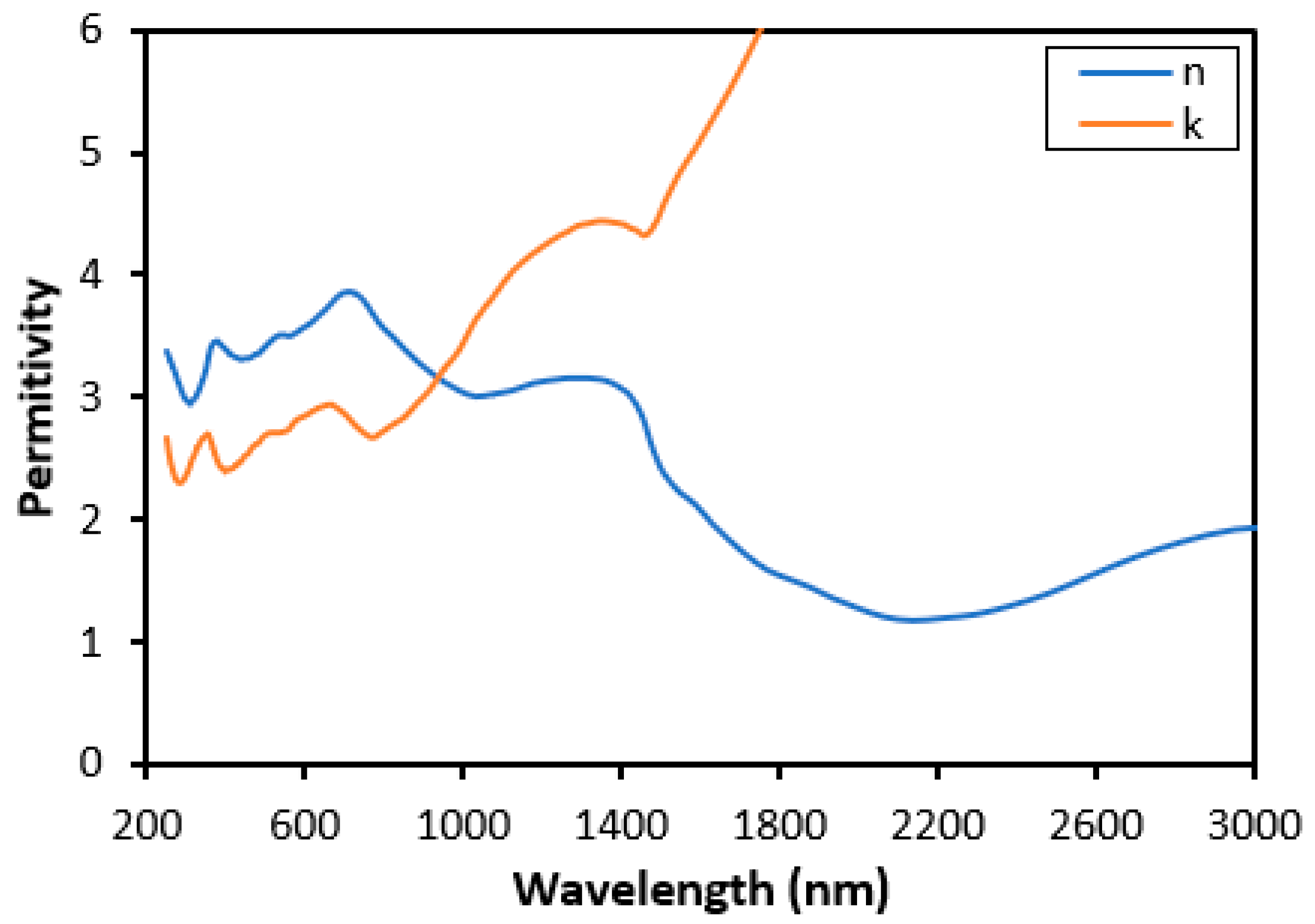


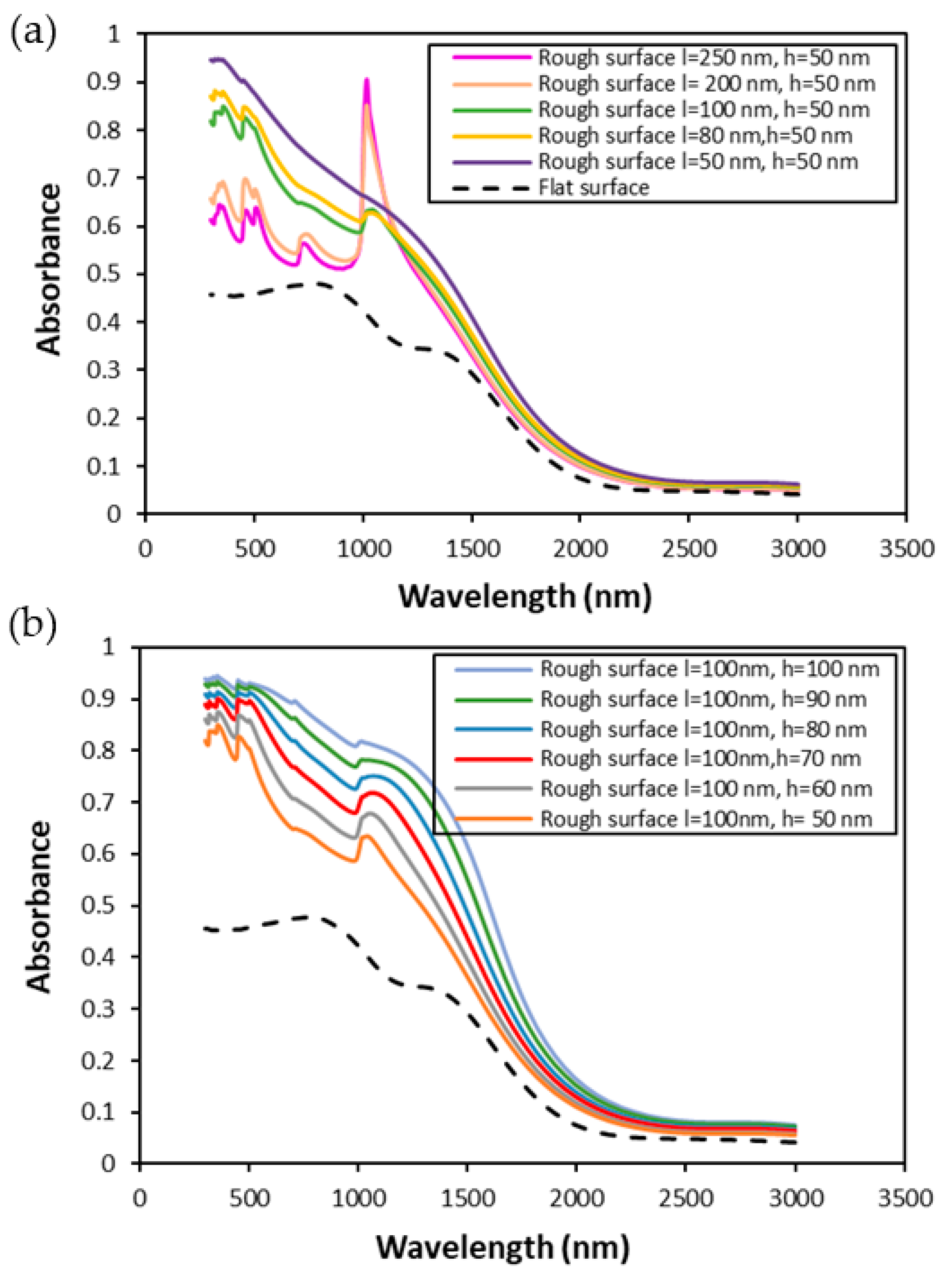

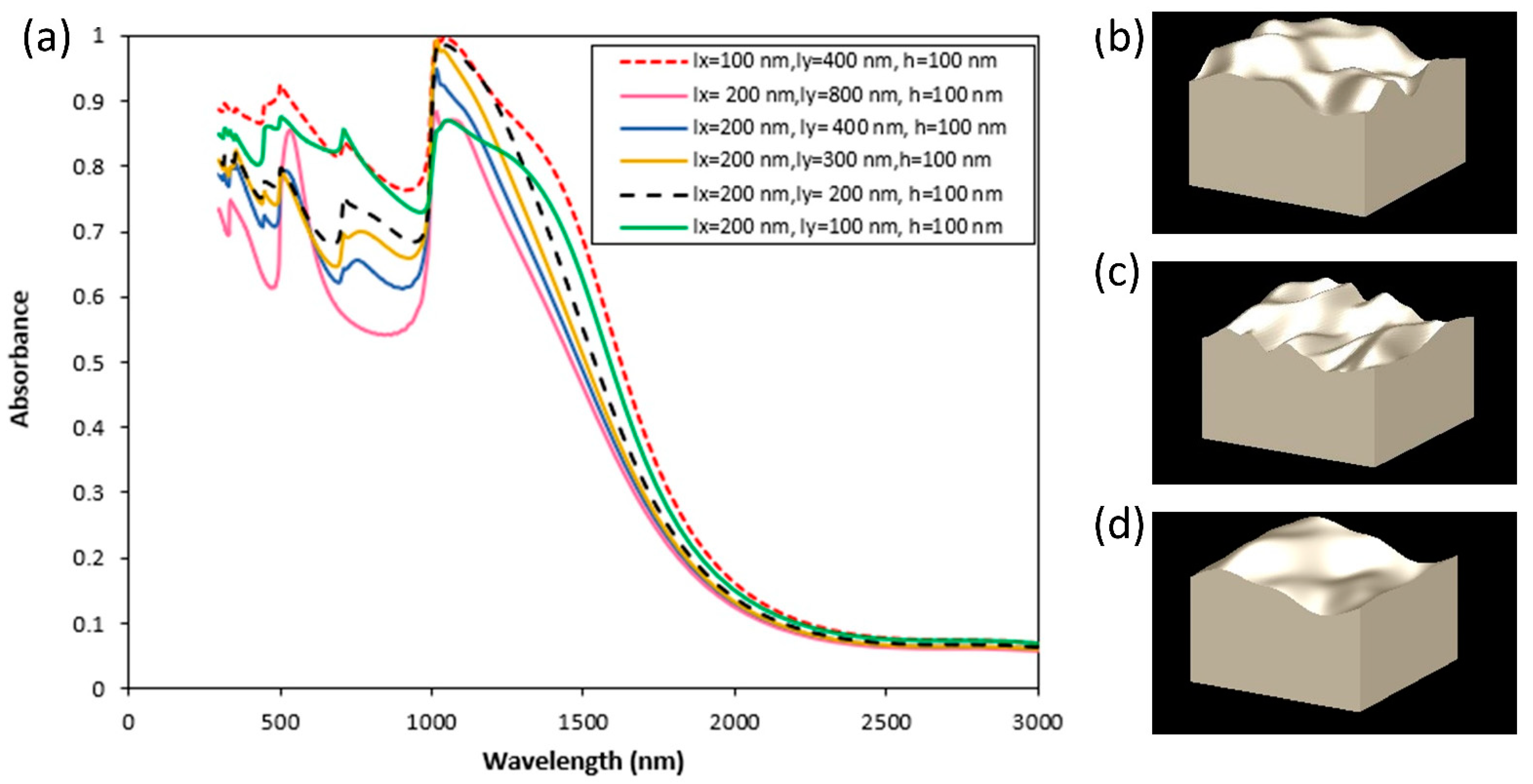
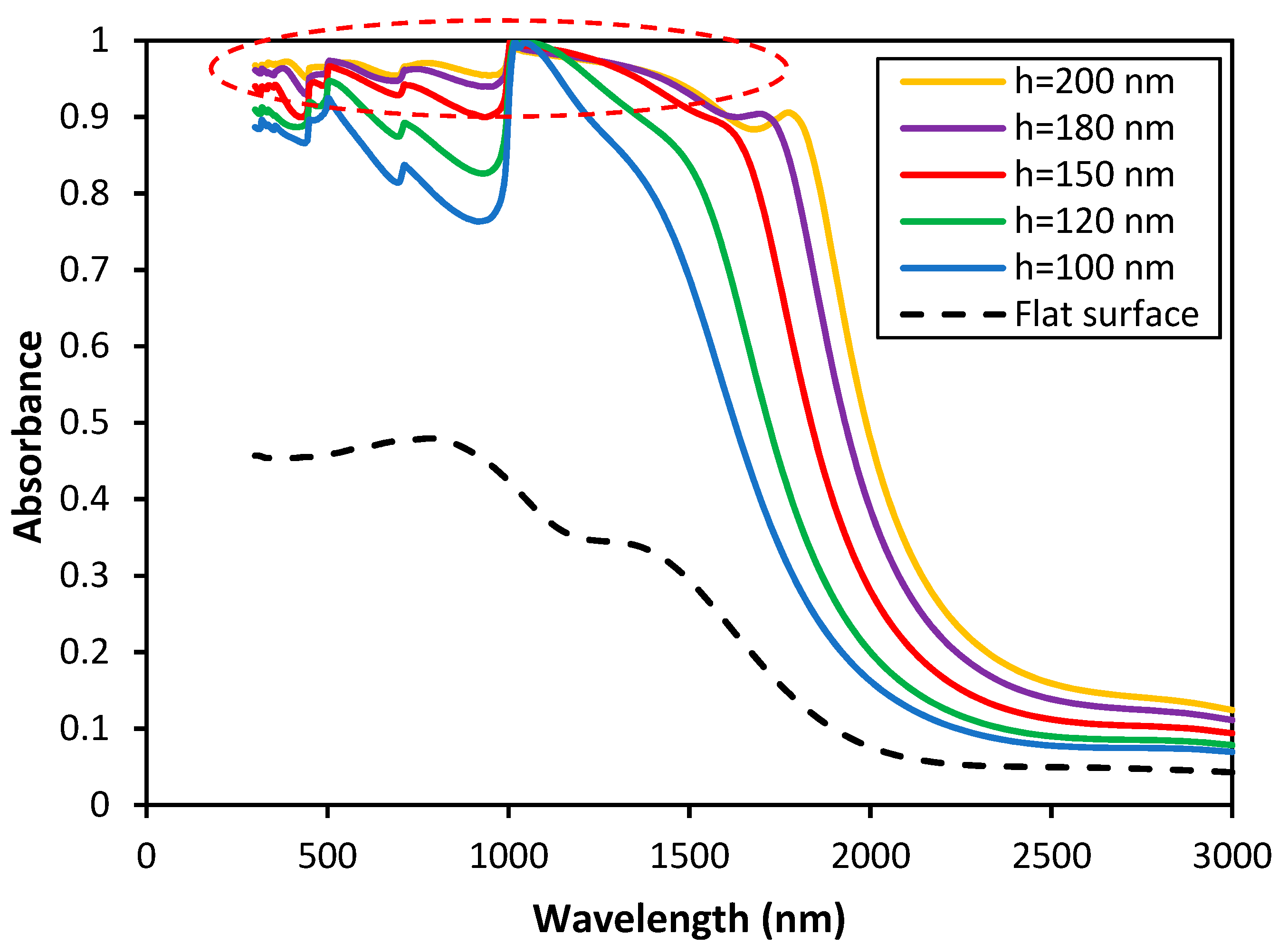
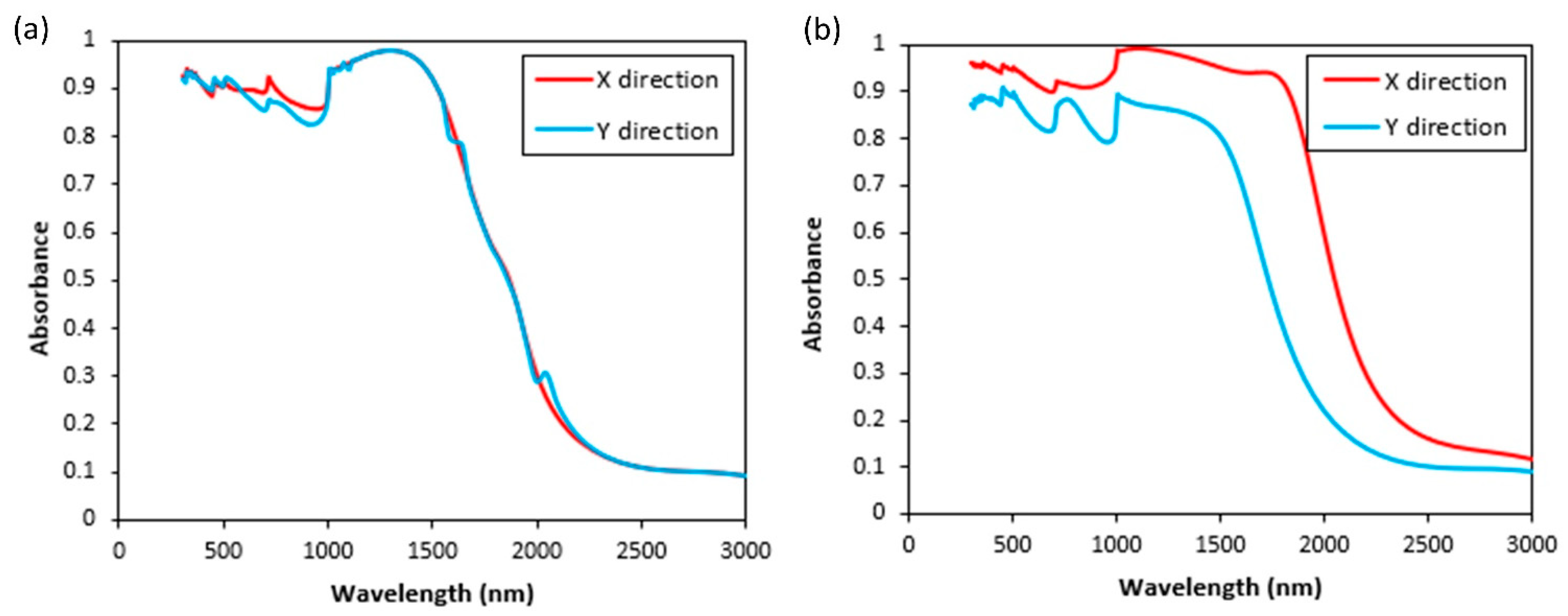
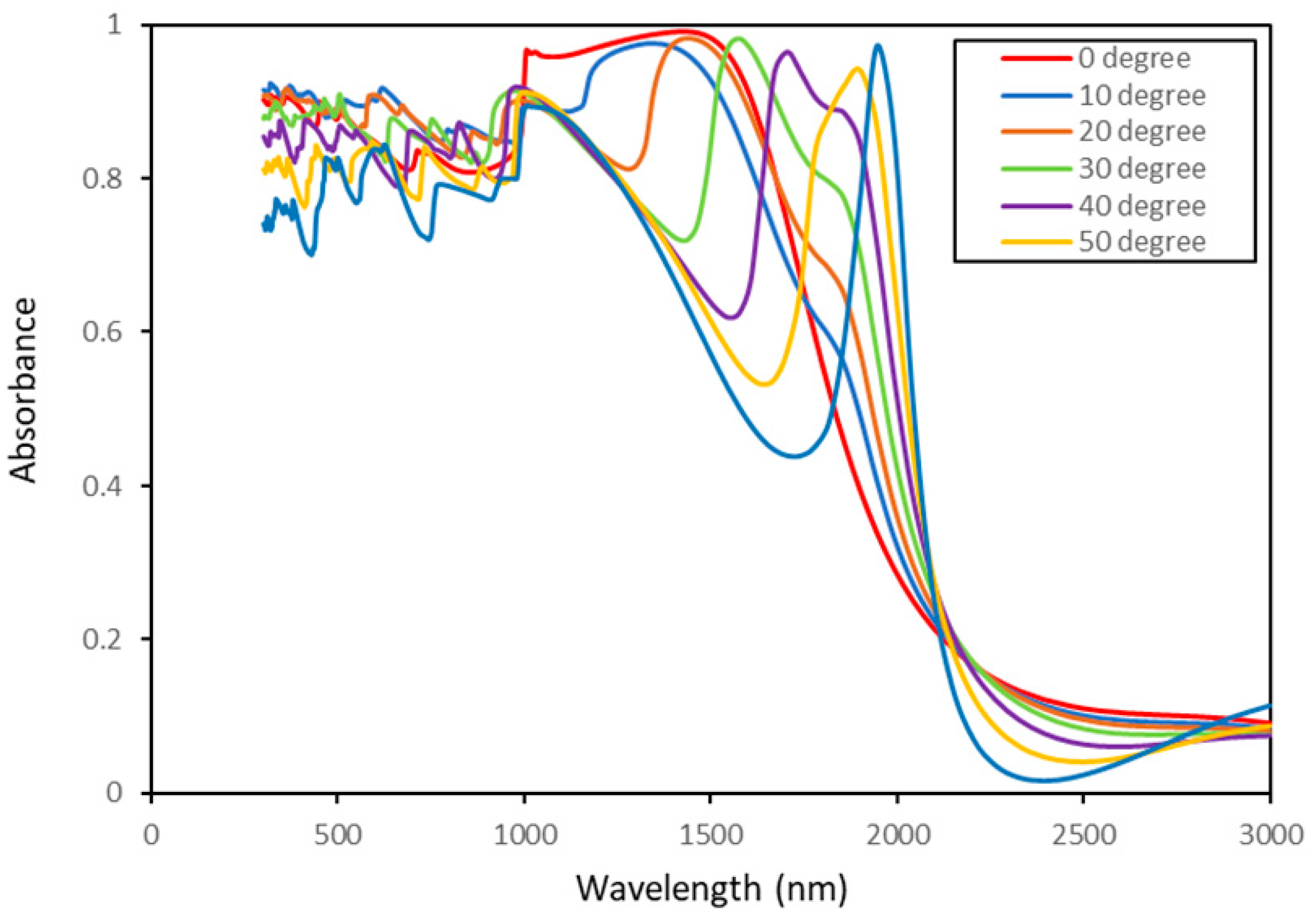
Publisher’s Note: MDPI stays neutral with regard to jurisdictional claims in published maps and institutional affiliations. |
© 2021 by the authors. Licensee MDPI, Basel, Switzerland. This article is an open access article distributed under the terms and conditions of the Creative Commons Attribution (CC BY) license (https://creativecommons.org/licenses/by/4.0/).
Share and Cite
Pirouzfam, N.; Sendur, K. Tungsten Based Spectrally Selective Absorbers with Anisotropic Rough Surface Texture. Nanomaterials 2021, 11, 2018. https://doi.org/10.3390/nano11082018
Pirouzfam N, Sendur K. Tungsten Based Spectrally Selective Absorbers with Anisotropic Rough Surface Texture. Nanomaterials. 2021; 11(8):2018. https://doi.org/10.3390/nano11082018
Chicago/Turabian StylePirouzfam, Niloufar, and Kursat Sendur. 2021. "Tungsten Based Spectrally Selective Absorbers with Anisotropic Rough Surface Texture" Nanomaterials 11, no. 8: 2018. https://doi.org/10.3390/nano11082018
APA StylePirouzfam, N., & Sendur, K. (2021). Tungsten Based Spectrally Selective Absorbers with Anisotropic Rough Surface Texture. Nanomaterials, 11(8), 2018. https://doi.org/10.3390/nano11082018





